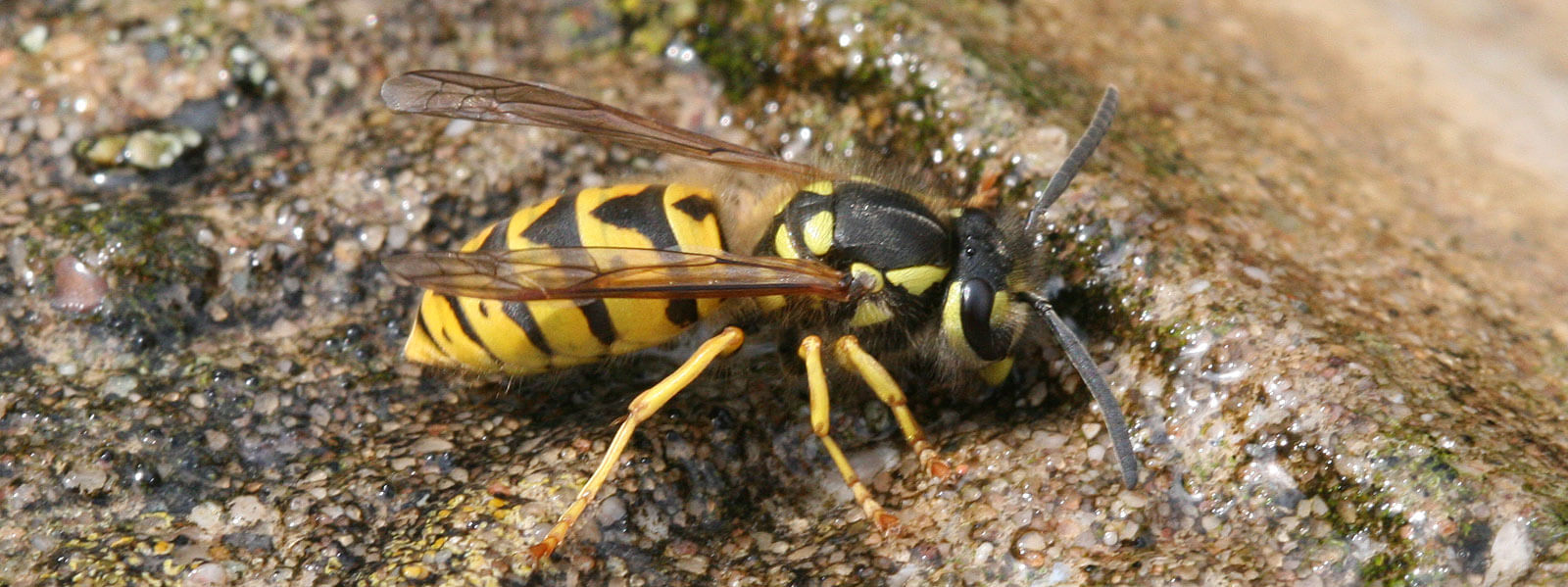Wasps
What's black and yellow and strikes fear in the heart of grown men? Answer; the humble wasp. Wasps have a bad image. Yes, they sting but not if left alone. In fact they are very beneficial insects with a highly developed social structure.
This page was put together after receiving many enquiries about wasps following a particularly bad summer for them and is aimed at a UK audience. It is meant only as a source of background information.
If you are at all worried by them then contact your local Public Health Department. If you are stung and are allergic to stings generally then seek medical attention immediately.
Know your enemy!
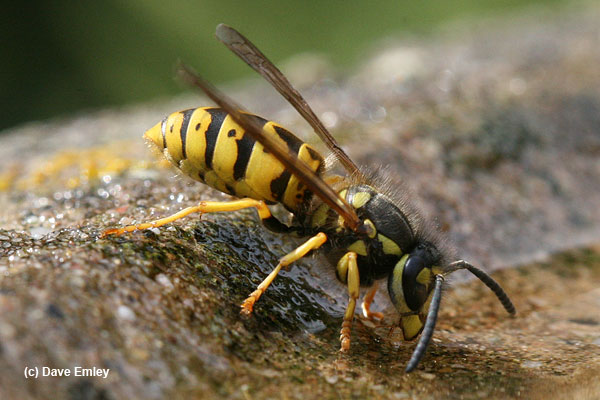 The black and yellow colouring of the wasp has been used by a number of harmless insects as a means protection, so first we need be sure that we are indeed looking at a wasp.
The black and yellow colouring of the wasp has been used by a number of harmless insects as a means protection, so first we need be sure that we are indeed looking at a wasp.
Wasps belong to the group of insects known as the Hymenoptera which also includes the sawflies, ichneumons, bees and ants. There are many species of wasp but the group that we are concerned with is the Social Wasps belonging to the family Vespidae.
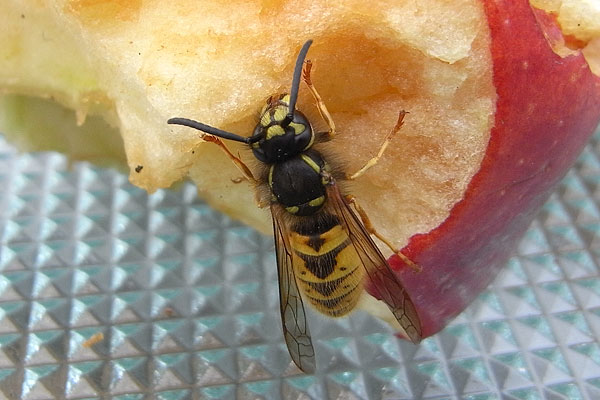 Looking at the photographs above of a worker Wasp Vespula the main characteristics are:
Looking at the photographs above of a worker Wasp Vespula the main characteristics are:
- Fairly large insects with a marked constriction or waist in the middle of the body, between the thorax and abdomen.
- They are brightly banded in black and yellow or in the case of the Hornet, yellow and brown.
- Fairly long, thick antennae. There are 12 segments in the female and 13 in the male.
- Two pairs of wings. The hind pair are usually hidden beneath the front pair and, when at rest, the wings are folded lengthwise in the manner of a fan.
- A pair of biting/scraping mandibles.
The needle-like sting is concealed near the tip of the abdomen. It is a modified ovipositor and is therefore only possessed by the female - male wasps do not sting.
Both the queens and the workers are females and develop from fertilised eggs.
Workers are smaller than queens and never lay fertilised eggs.
Male wasps are also smaller than queens and they develop from unfertilised eggs laid by queens or sometimes by workers in the autumn.
Similar Insects
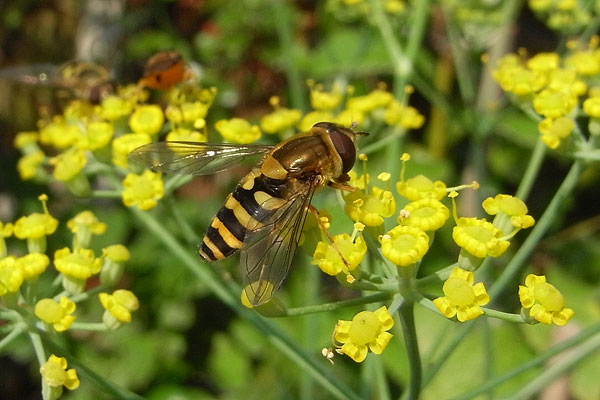
There are many other, harmless, insects that have a yellow-and-black colour scheme. They gain protection by resembling wasps. These include the hoverflies which have only one pair of wings and small three-segmented antennae .
How many species?
There are seven species of social wasp in the UK. The commonest is the Common Wasp Vespula vulgaris followed by the German Wasp Vespula germanica, both of which nest underground and in cavities in trees, walls and buildings.
The Tree Wasp Dolichovespula sylvestris is locally common and very aggressive and builds its nest in trees and other aerial sites as well as underground.
The Norwegian Wasp Dolichovespula norwegica is less common in the southern half of Britain but is the dominant species in Scotland. It builds its nest among twigs and branches.
The Cuckoo Wasp Vespula austriaca does not have workers of its own and lays its eggs in the nest of another species - the Red Wasp Vespula rufa - which nests underground.
The largest - the Hornet Vespa crabro - is largely a southern species which nests in hollow trees or in buildings but, with the recent series of mild winters, it is being found much further north and is now not uncommon in North Staffordshire.
The differences between the species are subtle but they all have similar black and yellow markings and THEY ALL STING!

Life Cycle
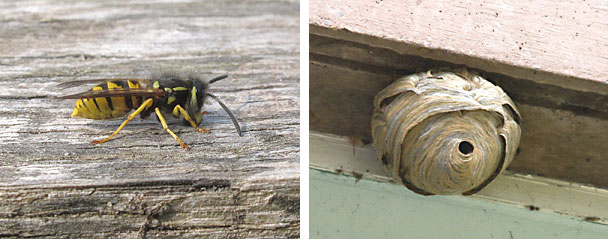
Wasp collecting wood shavings and a typical wasp nest
- The fertilised queen emerges from hibernation in the spring and sets about looking for a suitable nest site. For the Common Wasp Vespula vulgaris this is usually a hole in the ground but may be a cavity in the loft or in a garden shed.
- She sets about making a basic nest constructed from chewed wood pulp mixed with saliva.
- She starts by constructing a single layer or canopy and works outwards until she reaches the edges of the cavity. Beneath that she constructs a stalk to which she attaches several cells in which she lays eggs.
- These fertilised eggs will develop into sterile females known as workers.
- She initially raises the first few sets of eggs herself until enough workers exist to maintain the offspring and to build the nest without her assistance.
- The queen's only job now is to lay more eggs.
- By the end of July she will have produced enough workers (may be up to 10,000) for them to completely take over the maintenance of the nest and the feeding of the larvae etc.
- Towards the end of the autumn larger cells - known as "Royal Cells" - are constructed and are used to rear the queens that will found next year's colonies (it would appear that whether a larva develops into a worker or a Queen depends to some extent on the amount and type of food given to it). Males are also produced at the same time from unfertilised eggs. These leave the nest, mate and the mated females (future queens), then overwinter to start the cycle again.
- Meanwhile, the founder queen, the males and all the workers die and the nest becomes deserted.
What do they feed on?
The grubs require a largely protein diet and they are thus fed on masticated insect prey brought in by foraging workers, but rotting meat and fish may also be used. The workers, however, need mainly energy foods ie. carbohydrates and thus favour nectar and a variety of sweet substances such as fresh and processed fruits. There is also an exchange of foods between the grubs and the workers that feed them in that the grubs secrete a sweet liquid that the workers drink. The queen, when confined to the nest, is fed on a mixture of nectar, fruit and meat juices by the workers.
Population Levels
The number of wasps in the late summer/autumn depends on two things.
- The number of females overwintering
- The weather in April/May when the queens are trying to set up the colony.
A bad spring will mean that many nests are destroyed so fewer wasps are produced.
A large number of females overwintering will mean more competition for nest sites etc. in spring so the surviving queens will be in poorer condition and therefore fewer offspring will be produced.
The best conditions for numbers are therefore a dry spring and fewer overwintering females. The colonies will then be successful, producing many offspring and many overwintering females.
The following year, however, should see lower numbers because of the competition from many overwintering females hence the good and bad years for wasps that we observe.
Aggressive Behaviour
Left alone, wasps are not normally aggressive. However, they become more aggressive as a result of crowding and temperature.
The temperature of a wasp's nest is 5 - 10oC above outside temperature. So, on a hot summer's day with outside temperatures around 26-32oC the temperature inside a wasp's nest can be very high indeed.
Overcrowding or high temperatures can lead to aggressive behaviour both in wasps and Man therefore any slight irritation can cause an aggressive response.
The Sting
The sting is the object of our fear of wasps. Unlike that of the bee, the wasp sting has no barbs and can be used many times. The sting is, in fact, a modified ovipositor and therefore the male wasps are unable to sting. At the base of the sting is a venom-containing sac. The wasp can squeeze this sac and thus deliver the venom. The venom contains a pheromone which acts as an alarm to other wasps in the area and they can soon join in! The pain of the sting is caused by a complex protein injected through the needle-like sting as it penetrates the skin. Individuals react differently: some are hardly affected, others may suffer pain and swelling while in other, rare cases, individuals may suffer serious allergic reactions which may result in death from anaphylactic shock.
Cures for wasp stings are many. Here are a few of the more wacky ones from the 15th century:
A plaster of wild mallow leaves
Oil of bay
Vinegar and salt tempered with honey
Goose dung
Contrary to popular belief a wasp sting has a pH of 6.8 to 6.9 so is neutral NOT acidic, therefore the application of an alkali will do no good.
The important thing is to:
- Wash with soap and water
- Apply a antihistamine spray/cream or take antihistamine tablets
- Apply an ice-pack (a pack of frozen peas or similar will do) to reduce swelling - always place a towel or similar between the ice pack and the skin to prevent an ice burn!
- Seek medical attention immediately if you are susceptible to insect bites generally.
Wasps as Pests
Wasps can cause serious damage to soft fruit but ripening apples and pears are unlikely to be affected unless first damaged by birds or caterpillars. Wasps can be a considerable pest in sugar warehouses, jam factories and other sites containing sweet-smelling substances. They are a nuisance in houses where food is being cooked or eaten. They are also a serious pest of hive bees in some seasons. In the spring workers will attack and carry off foraging worker bees while later in the year they will take honey and carry off bee grubs and pupae.
Wasps as Friends
Wasps are extremely beneficial animals. They feed their young on a wide range of invertebrates and in so doing help to control many insect pests. They also visit flowers and therefore help in pollination.
What can I do about them?
So, you've got wasps and you now know a lot about them, but you still want to get rid of them. What do you do? The answer is simple; call your local Public Health Department. Wasps are best left to the professionals. If you try and remove them yourself you will only get stung - probably many times!
If you are happy to put up with them - they will not attack you unless they are antagonised - then by late autumn the colony will have died out and you can safely remove the nest.


